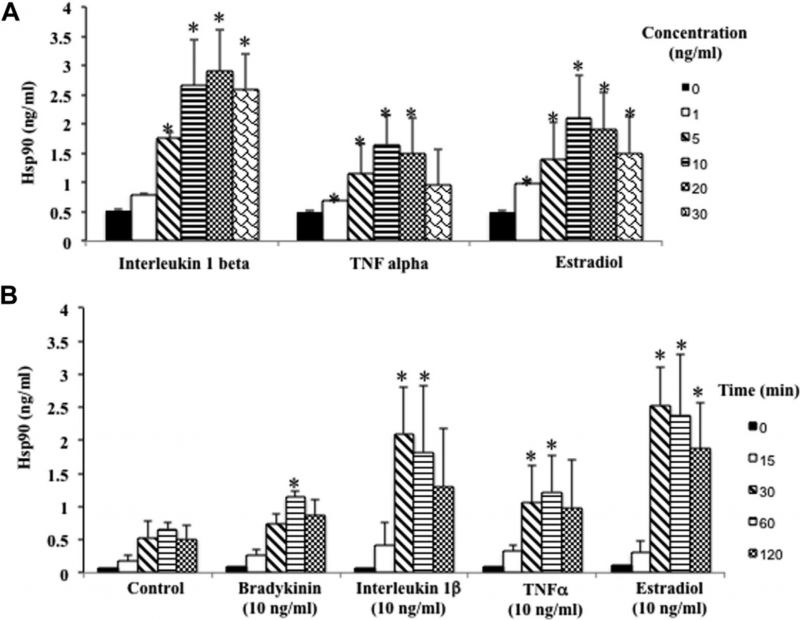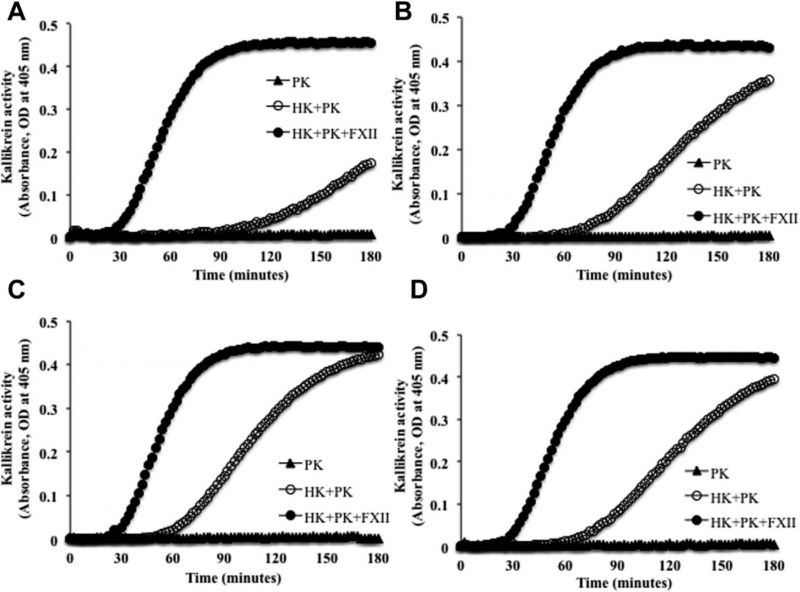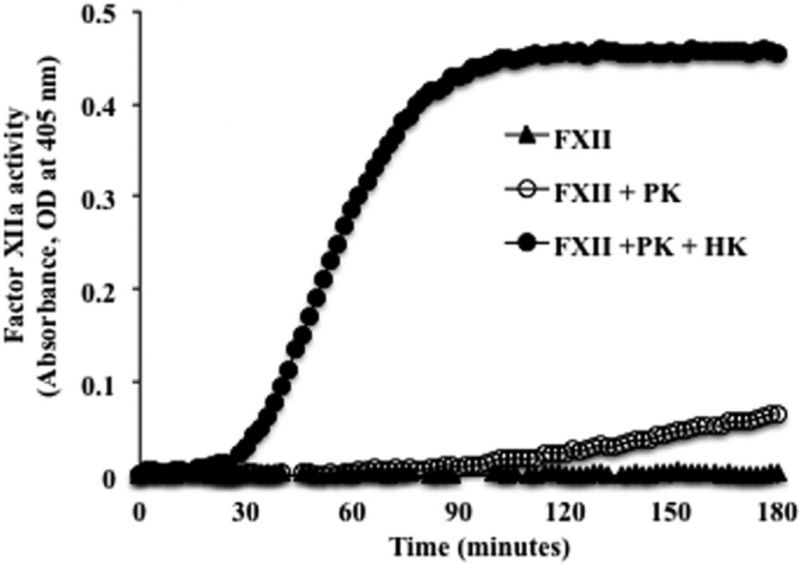研究背景:
激肽释放酶-激肽系统(KKS)是机体内重要的生理调节系统,参与多种器官功能调节和多种疾病的生理过程,如心血管系统、肾脏、神经系统的调节,另外平滑肌收缩、葡萄糖代谢、细胞增殖、炎症和疼痛都跟KKS有关。
激肽释放酶的作用底物是激肽原,包括组织型和血浆型。哺乳动物中主要存在3种激肽原:低分子量激肽原(LK),主要存在于组织液中;高分子量激肽原(HK)主要存在于血浆。
激肽原在激肽释放酶催化作用下激活形成有活性的物质激肽,生理条件下最主要的激肽是缓激肽(BK)。
因子XII曾被认为是KKS在内皮细胞表面活化产生级联反应的始动因子,也有研究证明HK与前激肽释放酶(PK)形成复合物HK×PK存在于循环系统中,内皮细胞粘附后活化PK转化成激肽释放酶并与底物HK反应释放BK,BK使内皮细胞释放组织纤溶酶原激活物(TPA)、NO、PGI2等生理活性物质。
现有研究表明HK×PK的激活可不依赖因子XII,热休克蛋白(Hsp90)释放可能促进BK的形成。但促进BK形成的因素及其机制仍不明确。遗传性血管水肿是由基因缺陷导致的导致血浆BK含量过高导致的血管性水肿,主要发生在凝血因子XII位点。
血管性水肿几乎发生于女性体内雌激素水平过高时,如:妊娠期或服用雌激素类避孕药后,预示雌激素能诱发血管水肿,其机制需要进一步的研究来阐述。
研究目的:
研究雌激素和细胞因子IL-1、TNF-α等是否促进HSP90的释放从而导致BK释放增加。
研究意义:这篇文献研究的是细胞因子和雌激素对内皮细胞BK形成的影响,结果表明雌激素能够激活HK·PK复合物导致BK含量增多,从而可以解释血管性水肿为什么发生在女性人群,尤其是妊娠期和服用雌激素后的女性。本次研究为研究血管性水肿的发病机制提供了一种研究方向,为研究血管性水肿的药物治疗提供思路。
研究方法:
1、将HK×PK和Hsp90结合形成可在刺激作用下相互作用的三分子复合物。
2、使用因子XII、IL-1、TNF-α、雌激素分别或者共同作用与内皮细胞,然后通过ELISA检测Hsp90、尿激酶、TPA的含量。
3、然后使用S2302显色剂检测BK的变化。
结果:
结论:
1、 IL-1、TNF-α、雌激素都能促进Hsp90的释放,但对TPA的形成没有影响。
2、IL-1、TNF-α以及凝血酶(阳性对照)能促进尿激酶的产生,而雌激素没有作用。
3、Hsp90含量增多能激活HK·PK复合物的激活,促进BK的释放。
FIG 1. Hsp90 binding to HK and prekallikrein. Increasing concentrations of HK (A) and prekallikrein (B) were incubated in Hsp90 (5mg/mL)-coated plates for 1 hour and probed with polyclonal antibodies to each followed by secondary antibody and color development. The binding was performed in the presence or absence of 50 mM zinc chloride. Each concentration was in duplicate and the assay was performed at 3 times.

FIG 2. Hsp90 release from activated endothelial cells. Cells were grown in 24-well plate with 0.5 mL medium. When confluent, the cells were washed and changed to serum-free medium for treatment with bradykinin, IL-1-b, TNF-a, and estradiol and incubated at 378C. A, Dose-response: Cells were treated for 2 hours with varying concentrations of each compound as indicated and the supernatant was collected and assayed by ELISA. The graph represents mean 6 SD of 3 separate experiments.Values that are significantly higher than control are indicated with asterisks (*P < .05). B, Time course: Samples were collected at indicated times and the levels of Hsp90 released were measured by ELISA. The graph represents mean 6SD of 3 separate experiments. *Indicate values that are significantly higher than control (P < .05) at a comparable time point.

FIG 3. Kallikrein formation on stimulated human umbilical vein endothelial cells. Cells were grown in 96-well plate with 0.2 mL medium. When confluent, the cells were washed and changed to serum-free medium and treated with IL-1-b (B), TNF-a (C), and estradiol (D) for 1 hour before the addition of HK, prekallikrein (PK), and factor XII (FXII). The kallikrein activity was measured using a chromogenic substrate
(S2302, Diapharma). Kallikrein formation on untreated control cells is shown in A. The experiments were. performed 3 times with similar results and a representative curve is shown.

FIG 4. Factor XII activation on endothelial cells in the presence of prekallikrein and HK. The experiments were performed 3 times with similar results and a representative curve is shown.

FIG 5. Urokinase and tissue plasminogen activator release from endothelial cells. Cells were grown in 24-well plate with 0.5 mL medium. When confluent, the cells were washed and changed to serum-free medium for treatment with thrombin, bradykinin, IL-1-b, TNF-a, and estradiol and incubated at 378C. Samples were collected at indicated times and the levels of urokinase (A) and TPA (B) released was measured by ELISA. The experiments were performed 3 times with duplicate wells, and the graphs represent mean 6 SD. *Indicate values that are significantly higher than control (P < .001).

IF:13.081
PMID:27826093 DOI:10.1016/j.jaci.2016.09.032
参考文献: Joseph, K., B.G. Tholanikunnel, and A.P. Kaplan, Cytokine and estrogen stimulation of endothelial cells augments activation of the prekallikrein-high molecular weight kininogen complex: Implications for hereditary angioedema. J Allergy Clin Immunol[J], 2017. 140(1): p. 170-176.
下一篇:没有了

